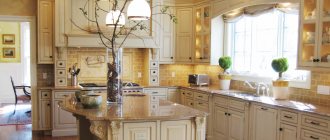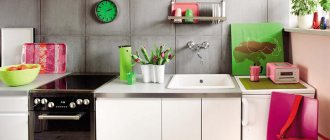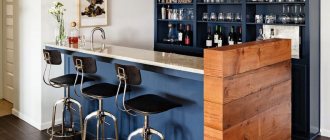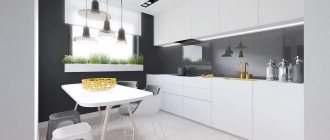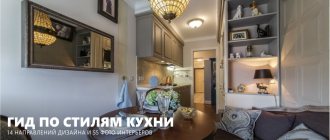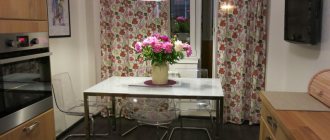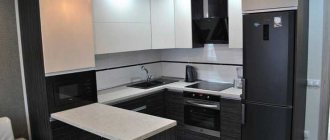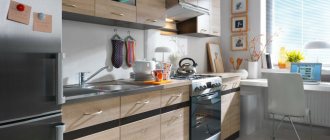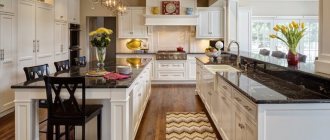Due to the mixture of styles, the interior of German houses looked overloaded and somewhat ironic. The German style of the late 19th century was called the “bug renaissance”, this is a kind of mockery of the way German living quarters were decorated. In the thirties of the 20th century, the German architect and artist V. Gropius introduced new trends into the German interior.
Now the German style in the interior is considered an ethno-style with characteristic features, which include German restraint and some conservatism. Pragmatism and rationality are the main companions of the German interior style. In such an interior you are unlikely to find any unnecessary details or accessories.
Features of the German interior are
The absence of rounded shapes in the interior is pure geometry (constructivism), minimalism and functionality. The color scheme must be light to create the effect of free space.
Before creating a German interior in an apartment, you need to make sure that the view from the windows is aesthetically pleasing, otherwise the essence of the German interior will disappear. For this reason, windows are given greater importance than in all other styles; as a rule, windows are not curtained with dark curtains, but decorated with light transparent tulle; It is important that the frames on the windows do not overload their appearance.
Much attention is paid to lighting in the German style in the interior; one room can have more than 4 lamps in addition to the chandelier itself.
A dark wooden floor or a floor decorated with a laminate that imitates natural wood is preferable.
Furniture in a German interior is no longer intended to create an aesthetic image, but for the comfort of the owners, which is why furniture made from solid wood in dark shades is often used in German interiors; It is necessary to have multifunctional furniture: shelving and various cabinets.
There shouldn’t be a lot of accessories in a German interior; you can do without them altogether, but to give the atmosphere of old Germany, you can hang small pictures in wooden frames depicting traditional German architecture on the walls. German style in the interior involves the presence of flowers in vases. It would be better if they were in every room.
- This style does not tolerate excessive pretentiousness. The main thing to remember is functionality and minimalism in details;
- Preference is given to furniture with a clear geometric shape, constructivism in its purest form;
- The color scheme is predominantly light. This choice is determined by the desire to expand the space of the room. The floor, on the contrary, should be dark, natural wood or made of laminate with an imitation of natural patterns;
- The Germans attach great importance to windows in their homes. Therefore, their appearance should be neat and aesthetic. Also, do not use heavy dark curtains and drapes. Choose better lightweight, weightless fabrics in light shades;
- Since space lighting plays an important role, the number of lighting fixtures can be maximum. In addition to the central chandelier, you can place floor lamps, lamps and lamps in different corners of the room;
- Furniture in a German home should be convenient, comfortable and functional. These are the basic requirements. Aesthetic appearance and design are not the most important thing. At the same time, furniture must be durable, so preference is given to high-quality models made from solid wood. All kinds of storage systems (racks and cabinets) are responsible for functionality;
- German style in the interior does not tolerate an excessive amount of accessories and trinkets. The most you can expect are small paintings in wooden frames and fresh flowers.
Living room.
The set of furniture for any standard German living room is, in general, the same - a comfortable sofa and a pair of armchairs, a table on thin graceful long legs, a sideboard (shelves), a chest of drawers. It is advisable that the furniture be made of solid wood. A small number of paintings on the walls or family photographs, as well as thin translucent curtains will make the room even more cozy.
Kitchen.
The main condition is that the kitchen should be comfortable. Therefore, all furniture, household appliances and utensils are arranged so that, first of all, the hostess feels comfortable. A dark floor, preferably tiled, shiny clean metal utensils, glossy furniture surfaces - all this is very German. Also, do not forget that kitchen appliances should be the most modern.
Are your distinctive features pragmatism and rationalism? Then the German style of apartment decoration is ideal for you.
Coziness and convenience are the hallmarks of German style.
Only the German version of the design perfectly combines comfort and functionality. No other style can offer you such a wonderful “duet”.
All interior details, from appliances to accessories, are arranged in such a way that the owner of the house feels comfortable. This interior is also characterized by simplicity.
When choosing a German style, remember that its distinctive feature is a sense of freedom, i.e. there should be a minimum of furniture.
It can be compared to minimalism: no unnecessary details, clear lines, any piece of furniture has a specific purpose. Evaluate the photo of the German style in the interior, and you will understand how wonderful an apartment without frills can look.
German classic furniture and accessories
German interior furniture should be not only practical, but also rational. This way she will be able to fit harmoniously into the overall design of the rooms. Stick to classic proportions.
Comfortable sofas and armchairs, elegant tables with thin legs, sideboards, shelving - all this furniture is an example of comfort without unnecessary decoration. When choosing furniture, first of all, focus on its functionality and only then on design.
German-style furniture is distinguished by clear, strict lines. Make sure all furniture is free of decorative trim. It is desirable that it be made of natural material - this will emphasize its high quality and high cost.
Fresh flowers can be distributed throughout the house: place them on window sills, place them on the walls in flowerpots, place them on the floor in large tubs. Do not use artificial flowers under any circumstances!
Windows should be large, because German interior design provides for plenty of natural light. Choose curtains that are weightless, translucent, without unnecessary decoration. Use chandeliers for artificial lighting.
It is better to cover the floors with laminate that imitates wood. Cover the walls with wallpaper in a delicate shade. You can hang photographs or paintings of flowers.
Furnishing features
Furniture that suits this style is an example of practicality and, at the same time, classic, strict proportions. So, when arranging a room, you should pay attention to: - small, comfortable sofas and armchairs; — neat, non-massive tables; - low buffets; - open shelving.
The aesthetics of things is important, but when choosing furniture, Germans, first of all, pay attention to durability and functionality. There is no place in a German home for an elegant but useless piece of furniture. Everything should be extremely logical: a chair for comfortable sitting, a sofa for proper rest... In a German home, household items honestly fulfill their intended roles. The furniture can be new or antique, “rustic” (if the decor is country-style), but it must be of high quality and solid in appearance. Most often it is wooden, with trim or inserts made of genuine leather. The upholstery is always in a discreet color: chocolate, bottle green, sand gray, dark burgundy.
Does this environment seem bland and boring to you? — Try adding a couple of vintage, typically German things - a Singer sewing machine, for example (or a dressing table based on it) or an old Viennese chair as a stand for a flower pot... And the room will immediately breathe with homely warmth, filled with the air of a previous era!
The main feature of the German bedroom is a large, solid, reliable bed. The rest room is not cluttered with wardrobes and chests of drawers, leaving it as spacious as possible.
In the living room, the furniture is often polished; the German kitchen also shines with the same gloss - thanks to the polished utensils. Perhaps the kitchen is the most important room in the house. This is a symbol of truly German character, a temple of purity and order. Here every little thing has its place; meat grinders and coffee grinders sparkle like orders on the chest of a commander, and on a large, open shelf there is a family set, a grandmother’s jam basin, and an antique mortar for spices.
As for the bathroom, it is equipped with only the most necessary plumbing fixtures of such a design that it is convenient to clean and wash. You can completely abandon the large, traditional basin, giving preference to the newest, but without unnecessary “bells and whistles” shower stall.
Specific features of the German style
The German style is distinguished by practicality and convenience; it cannot be confused with any other. Increasingly, Europeans prefer decorating their homes in the German style.
The most important difference between the style is the embodiment of naturalness, which borders on simple. You will not see a hint of extravagance or refinement of taste. Also, don't expect your apartment to have stucco or any other fancy details.
The smallest design details are simple and rigorous. The colors used in the German style are characterized by restraint and limitations. The designers creating this interior try to achieve only one goal - to achieve maximum practicality while maintaining high quality.
To decorate apartments in German style, they use only natural materials that do not harm the environment.
Of course, this interior design option will not appeal to every person. If you are a fan of a large number of trinkets and store a huge number of things at home, then you are better off choosing some other stylistic design direction.
German style decor elements
German houses are decorated with elegant mirrors, sophisticated vases, beer mugs, busts of German philosophers, photographs, and paintings. All these decorative items should be in place, harmoniously combined and complement each other. The Germans love flowers very much. They are everywhere, on window sills and balconies, on floors and walls.
To make German simplicity a reality, you need to reconsider your attitude towards everything, then you will succeed!
We recommend watching:
- Grunge style in the interior
- Hygge in the interior - cozy Danish design
- Design options for three-room apartments
- All wall finishing options
- Minimalism style
Photos of German style in the interior
Do you have a healthy pragmatism, love strict order and prefer reliability and functionality to external beauty? Then, even if you have no German ancestry, your ideal design is obvious. In particular, when planning a kitchen renovation, you should opt for the German style, one of the most practical and laconic among its European counterparts.
Such a room accurately conveys the character traits of the indigenous inhabitants of Germany. German style does not accept formality and ostentatious aesthetics. After all, its basis is the convenience of location and functionality of each piece of furniture.
Features of German cuisine
Seems. that such kitchens are made by robots, not people - everything is so verified, taken into account and provided for. Designers who have been working with such kitchens for many years find in them the reliability of German machines and the tenacity of German football players. And even if this is just a metaphor, such kitchens deserve the most enthusiastic reviews.
The concept of a built-in kitchen was invented in Germany back in the middle of the last century. And since then they have changed little structurally and even externally, acquiring only the features of modern design and decor - however, in a very laconic design.
Calculate the exact cost of repairs using an online calculator
and receive a free detailed estimate for repairs
Calculate
Photo: idealhome.co.uk
Most German kitchens these days are made in a modern style. If you want to install a set at home with smooth facades without handles, with a glossy or matte finish, your choice will be limited only by your budget. But in any case, such a set will have common features: smooth facades, rational storage systems, a complete lack of decor, predominantly monochromatic color schemes for decoration, the use of various lighting sources located at different levels.
Photo: idealhome.co.uk
German style in the kitchen as a way of life
This design is strikingly different from such elaborate and admirable trends as the Empire or classical style. For Germans, it is not the opinion of others about their home that is important, but compliance with their own ideas about what convenience, rationality and practicality are.
Therefore, a kitchen made in this style is fundamentally:
- furnished and decorated quite discreetly;
- sparkles clean and looks very fresh;
- has an extremely convenient and uncluttered layout;
- decorated in light colors that expand the space;
- abounds with fresh flowers;
- stands out for its smooth, glossy surfaces of regular shape;
- filled with both natural and artificial light.
Such a kitchen must be carefully thought out in order to correspond to its main characteristic feature: functionality. Each item should be in its place, and in such a way that it is easy to reach.
There is no room for luxury here, but the following mandatory features are present:
- attention to detail;
- high quality materials;
- perfect order;
- modern technical equipment.
That is why, despite its external unpretentiousness and seemingly excessive pedantry, a German-style kitchen is the dream of many housewives.
Decoration and decorative elements
The character of the German style is Nordic, a little prim... However, this does not mean that any decorative items are expelled from the home. A German house is usually decorated with:
- paintings (landscapes or still lifes);
- photos;
- mirrors in spectacular frames;
- beautiful vases;
- Bavarian beer mugs;
- small busts of German thinkers;
- Natural flowers.
The main thing is not to dump it all “in a heap”, but to use it sparingly, in the right places and in minimal quantities.
Fresh flowers are probably the only decorative element that can be seen in almost any “German” home. And both outside and inside. It is very German to place pots of living, blooming greenery not only on window sills and shelves, but also on the floor, along walls and stairs. Therefore, when decorating the interior in the German style, get ready for the fact that you will have to master the basics of floriculture. We are, however, talking about simple, common plants: geraniums, primroses, and Kalanchoe, one variety of which was not without reason called “Goethe’s flower.”
The interior of a “German” kitchen - comfort in the details
The obvious advantage of decorating a kitchen in a German style is its practical and very simple finish.
Judge for yourself:
- dark wooden parquet, laminate or glossy ceramic tiles on the floor;
- large, wide windows with wooden or plastic frames;
- light walls covered with plain wallpaper or painted;
- white ceiling with dark beams or suspended structures in the form of shelves.
It is important to strictly observe the proportions of the room in order to visually increase the free space through proper finishing. That is why the windows in such a kitchen should not be made very small and tightly curtained. If you are the owner of not an apartment, but a house, then you can add light using roof windows, which are so loved by the Germans.
There is also no need to “heavien” the interior with arches, cornices, stucco molding, partitions and other decorative elements. All this is unnecessary. A German-style kitchen should have a strict, regular shape.
Color palette in a German interior
Its main shades are calm and warming. Among the absolute favorites are milky, cream, olive and light coffee tones. The walls, as a rule, are as light as possible so that the furniture against their background looks clearer and more voluminous. And the floor is darker, with a beautiful pattern of gray alder, ash, pine, walnut or oak.
The combination of light and dark is a favorite technique of the German style: it makes the interior expressive and emphasizes the reigning pedantry.
Shade palette for Deutsch Küche
Unlike bright ethnic styles (Oriental, Ukrainian or African), German design is quite restrained in colors. You will not see eye-catching contrasts and provocative shades in such a kitchen.
Most often used for design:
- beige, cream, ivory;
- chocolate, light brown, sand;
- dark burgundy, terracotta;
- all shades of natural wood: ash, walnut, oak, pine.
The choice of colors is quite limited, but it only seems so. For example, beige alone has about 50 different tones from gray-pink beige to beige-honey. Choose to your heart's content!
Children's
The design of a children's room in German is strict and pretentiously neat. As with all other rooms, the interior of a German-style nursery has such features as: maximum comfort, practicality, safety and the use of natural materials.
The main design principles are minimalism and spaciousness. Furniture must be of good quality and high quality. Finishing in the nursery also includes a “warm floor” system, plastered walls or covered with cute wallpaper, ceramic tiles or parquet as flooring.
In private houses, as a rule, the child’s room is located on the second floor, where an additional bright, sunny space is specially created in the form of a window in the ceiling, which has proven itself perfectly in a child’s room.
Choosing furniture and decor for the kitchen in the German style
For a “German” kitchen, you should choose a simple, but very high-quality and expressive set. The lines should be clear, straight, the facade should be glossy, without painting, carving or inlay. Furniture that stands out for its exemplary practicality deserves special attention. Usually it comes with built-in equipment. And the mechanisms in it are created to make life easier. For example, all cabinet doors can be opened with one click and be equipped with closers.
What looks best in a German-style kitchen are:
- large work surfaces (both wall and island);
- convenient wall cabinets with glass doors;
- oval or rectangular table with chairs;
- bar counter;
- corner or U-shaped ready-made headsets.
Furniture can be made from both natural materials and high-quality plastic. It is possible to use modest upholstery on chairs. Also, as a textile addition to the interior, thin, even translucent curtains or Roman blinds are hung on the windows.
To illuminate the kitchen space at night, several large diffuse sources and many spotlights are usually installed. Chandeliers should not be too heavy and made of crystal or twisted forged parts. Ordinary glass shades are a classic of German style.
To decorate and liven up your kitchen, you can purchase the following accessories:
- German beer mugs;
- neat, stylish vases;
- paintings depicting landscapes or animals;
- fresh flowers in pots (you can decorate the entire windowsill with them);
- shiny metal utensils.
The German style of kitchen design is somewhat similar to modern modern. But at the same time, it has its own national flavor, which makes the interior comfortable and very practical. For those who are close to German pedantry and the desire to create a laconic and functional room, such a project will be an excellent investment of money and effort. Moreover, the result in the form of a reliable, high-quality and impeccably exemplary kitchen will delight you for many years to come.
They can be very different and no special details are striking, for example, in the “Provence” style.
The only thing that distinguishes them is: high-quality and “timeless” furniture made from natural materials, strict forms, floors predominantly made of wood and the presence of ultra-modern technology. It is almost impossible to find old, unusable refrigerators and stoves there.
The shapes of the furniture are extremely smooth, without any elaborate carvings or radius turns. No stucco on the ceilings, no “chic” curtains with lambrequins, no shining chandeliers.
Also, the German interior cannot contain bright plastic lampshades, work aprons with photo printing and other details that are so often found in our kitchens.
In general, the main thing in German cuisine is convenience and coziness. Every corner is intended for something and every thing is in its place. Well, it’s probably not worth saying that the symbol of German cuisine is almost sterile cleanliness. German housewives are famous throughout the world for their intolerance of disorder and chaos.
The furniture is thought out to the smallest detail and there are simply no inconvenient drawers in which little anything fits.
Layout of a kitchen ensemble in modern interiors
To a large extent, the layout of storage systems, work surfaces and household appliances depends on the size of the kitchen space, its shape and architectural features. Depending on how many door and window openings there are in the room, whether it is a walk-through room or has panoramic access to the backyard, and whether the kitchen space will have a dining area or there is a separate room for this, the layout of the furniture ensemble is drawn up.
Single row layout
The layout of the kitchen set in one row is the best option for a narrow kitchen. With such a layout, it is more difficult to comply with the rule of the working triangle without moving at least one component outside the furniture ensemble. But everything is possible if you follow the rule about the required safe distance between the stove (hob), sink and refrigerator.
A one-row layout can also be useful for a spacious kitchen area in which it is planned to install a full-fledged dining group. Arranging storage systems, work surfaces and household appliances in one row will be a rational and ergonomic design move if the width of the room is sufficient to install a spacious set, but not so huge that the hostess (owner) gets tired during the work process, moving between the stove, refrigerator and sink.
Layout in one row with an island or peninsula
A kitchen island has long ceased to be just a separate furniture module that helps increase the number of storage systems and work surfaces in the kitchen. A modern island is a multifunctional workstation, into the frame of which a hob or stove, a sink, or both can be integrated, if the dimensions of the structure allow. The lower part of the island can be represented not only by drawers or hinged cabinets, but also by a wine refrigerator or oven, a bookcase or a whole systematic exhibition of seasonings and oils for cooking.
Extending the countertop of a kitchen island or peninsula allows you to create a spacious dining area right in the kitchen. If space allows, then you can organize a segment not only for short meals, but also an area for family lunches and dinners.
A peninsula differs from a kitchen island in that one of its ends is attached to a wall or part of a furniture set. Thus, you lose the ability to approach the module from one side, but save useful kitchen space. Work surfaces, a sink or a hob are also integrated into the peninsula, and a counter for breakfasts or other short meals is organized.
Modern kitchen design strives to display the greatest possible practicality in a minimalist outfit. Even such a multifunctional room, which many associate with the heart of the home, its hearth, becomes similar to a commercial space in which there is no place for decor, textiles on the windows or sweet little things on open shelves that are of no interest from a practical point of view.
Parallel arrangement of kitchen units
A parallel layout is suitable for long but narrow rooms in which there is no possibility of installing a dining group or kitchen island. Often such spaces are passage rooms or rooms with an entrance and a full-wall window located opposite it. In order not to experience emotional pressure from the monolithic structures on both sides of the room, you can alternate closed cabinets in the upper tier with open shelves or completely abandon the use of furniture above the work surfaces.
U-shaped layout in the kitchen
If you are planning to use a U-shaped layout in the kitchen space, where you will need to install a dining table with chairs, then the room must be really large. Otherwise, placing a dining area or kitchen island is out of the question. The advantage of this arrangement is that the vertices of the working triangle (stove, sink and refrigerator) will be optimally spaced from each other.
Corner layout with kitchen island
Arranging the kitchen unit in an L-shape is one of the most versatile kitchen design options, which is suitable for both spacious rooms and small spaces. If the kitchen is spacious, then in addition to the furniture, a kitchen island of impressive size or a dining room with a large dining table is installed in the free space.
In a small kitchen space, an L-shaped kitchen unit layout may be the only possible option for arranging furniture and household appliances, especially if the placement of the top row of cabinets is hampered by the presence of window openings.
German style dishes
They prefer stainless steel cookware. It is durable, practical, easy to clean, and the cost is average. Also, tin and earthenware are very popular in daily use.
But the Germans prefer to bake in glass or ceramics, as it is environmentally friendly and convenient. If we are talking about holiday services, then to this day there is no porcelain of equal quality. At the same time, the ornament is very elegant, it is not replete with too many “embellishments” and gold, which is the fault of our and Czech sets.
There is probably no person in the world who has not heard of the Kahla brand or Mason porcelain. The prices for German sets are high, but they are worth it. Cutlery is mainly made of stainless steel, and on festive occasions silver is often used.
Lighting and textiles
Windows are the main “supplier” of light when it comes to German interior style. They are always spacious, rectangular in shape, outlined by light, non-rough frames. The source of artificial lighting is usually lamps under simple glass shades.
Crystal chandeliers, bronze, forged metal - for other interiors... He doesn’t like the German style and the abundance of small lighting fixtures, all kinds of sconces. If you cannot do without additional lighting (and it is difficult to do without it), you should limit yourself to a simple but elegant lamp made of frosted glass.
Since your home should have plenty of natural light, heavy curtains and drapes should be avoided. The windows are covered with light, translucent curtains.
A starch tablecloth with modest embroidery, a silk lampshade on a single table lamp and a pair of tapestry sofa cushions will not disturb the integrity of the style. All this, naturally, should not be variegated, muted in color and should be in harmony with each other.
What colors do Germans prefer in kitchen interiors?
Germans love natural colors. It can be the color of natural wood, or painted wood. If we are talking about artificial materials, it doesn’t matter that they don’t have any flashy shades. White, brown, beige - these are the main colors of German cuisine.
Neutral shades of furniture and walls do not look boring, as they are set off by textiles, to which the Germans are especially partial. Also, there are almost always small quantities of antique interior items that emphasize the flavor of the country.
For example: copper dishes, antique irons, kerosene lamps. But there is not too much of this, as in country styles of various directions.
They prefer either stone or wood countertops. Plastic is not welcome even in this case, despite the fact that it is quite practical. But it is also short-lived, as the Germans know very well.
Space decoration
The walls in the kitchen are usually decorated with natural materials - stone, glass, wood. It is also allowed to paint the walls in monochromatic colors, using paints that can be washed to remove dirt.
Mostly solid colors
Materials of natural shades are used for decoration:
- gray;
- dark brown;
- dark green;
- black;
- wood texture.
Natural shades are more welcome
The dark interior is compensated by a light kitchen unit and an abundance of light in the space. German interior always means a lot of natural and artificial light. At the same time, it is not recommended to use curtains or window curtains in the kitchen, because they darken the room and take up extra space.
Residents of Germany do not like unnecessary accessories, so they decorate the kitchen by playing with different textures - glass, leather, wood and stone. It is the contrast of these materials that creates the peculiarity of the interior.
There are almost no curtains in such kitchens
The only accessory that Germans can use in the kitchen is live plants. They can be placed on special shelves in the dining area, as well as on window sills. Palm trees, ficus and abutilon are great for German interiors.
Advice It is not necessary to put live plants in the kitchen. They can be replaced with artificial flowers, which are more practical and convenient.
An invariable attribute of any kitchen is living plants.
Textiles in the kitchen in German style
The window decoration here looks very interesting, homey. Only in Germany there are curtains that cover the lower half of the window, and on top, on the eaves, a small lambrequin and curtains are hung.
Fabrics for kitchen curtains are chosen in natural shades and mainly with floral patterns. The cage is also popular, and exclusively in pastel colors.
A German-style kitchen interior is unthinkable without tablecloths and chair covers. They should be in harmony with the curtains. Savings here are inappropriate, since without these details the interior will not be so cozy.
If you look at the German style kitchens pictured below, you will see that German kitchens are very similar to Scandinavian kitchens. One difference here: Scandinavian ones are less demanding about the availability of modern technology and allow the use of old gas stoves, refrigerators and other things.
In general, we can say that German cuisine is appropriate both in a private house and in an apartment. Whether on a large or small area, it is quite possible to recreate a small corner of Germany. This is a win-win option that you won’t get tired of too quickly.
Color palette - features of German design projects
It's safe to say that most German designers and homeowners prefer a light, neutral palette for their kitchen spaces. And this applies not only to the choice of surface finishes, but also to the facades of kitchen cabinets. Although, as always happens, there are exceptions to any rule, and some homeowners living in Germany prefer to highlight their interior by using original color schemes.
Black design elements for the kitchen - original interior
Of course, wenge-colored kitchen fronts are not a kitchen design option for everyone. First of all, dark furniture requires a large enough space so that the set looks organic and does not “crush” with its power and solidity. For a large-scale kitchen ensemble, it is better to use diluting elements - bright or shiny facade fittings, glass or mirror doors and inserts, alternating closed storage systems with open shelves or even racks.
A black kitchen set against the backdrop of snow-white walls creates an incredibly contrasting, dynamic and modern image of the entire room. Wooden surfaces in a dining room or kitchen island perfectly diversify this black and white monochrome.
The black wall, on which you can leave messages, write down culinary recipes and express yourself creatively, has become an original decoration in many European kitchens. Such a dark accent will not only allow you to create combinations with household appliances of a similar color, but will also bring contrast to the design of the kitchen space.
Total black for all kitchen furniture is a rare and very bold design move. A monolithic kitchen set does not put pressure on the image of the kitchen thanks to the finishing of surfaces using light wood and the use of snow-white gloss to decorate the apron. The dining group of the same shade brings even more constructiveness and clarity to the interior of the kitchen space.
A black textured wall as a background for snow-white glossy facades looks luxurious. Of course, finishing a kitchen apron like this will require a lot of effort when cleaning, but the attractive and interesting appearance compensates for all the effort.
Let's add brightness to the design of the kitchen space through finishing
The kitchen apron is the space above the work surfaces, in the design of which many homeowners allow themselves to use bright colors or variegated patterns. Ceramic tiles with expressive patterns can refresh and transform a kitchen space made in the most neutral colors.
A bright yellow mosaic apron in combination with the snow-white facades of the kitchen unit looks incredibly expressive. The effect of the positivity brought into the kitchen design is enhanced by the built-in lighting.
The beautiful emerald shade of the apron, turning into turquoise and mint tones of the kitchen facades, is the absolute highlight of the kitchen interior. For a more harmonious atmosphere in a multifunctional space, you can use these colors in the dining room or lighting fixtures.
A deep wine shade of Marsala for decorating kitchen walls is not just a bold design move, but also an interior element that brings a touch of luxury and originality to the design of the kitchen space. In combination with the snow-white facades of the kitchen unit, the shine of stainless steel household appliances and black and white flooring, the color of the walls looks impressive and attractive, becoming the highlight of the interior.
The colorful design of the flooring is not a common design technique for modern kitchen spaces. Meanwhile, ceramic tiles with a black and white pattern look very impressive, especially if you consider. That these colors have already been used in decorating or furnishing the room.
Snow-white kitchen is the modern mainstream
Not only German owners of apartments and private houses want to see a clean and bright image of the room in their kitchen. White color calms emotions, prevents appetite from going wild, clears our mind of negative thoughts and gives a feeling of lightness and freedom. But homeowners choose snow-white kitchen facades not only for aesthetic, but also practical qualities - white kitchen surfaces are easier to care for.
Snow-white smooth facades of kitchen cabinets are a common attribute of modern kitchens. The set looks residually monolithic, especially if the top row of cabinets starts from the ceiling itself. For such spaces, color accents are extremely necessary, otherwise the presence in a snow-white room may be associated with the sterility of the operating room.
The white color of the finishing and execution of kitchen furniture is recommended for rooms with a modest area. Light colors will help visually expand the space and hide design or finishing flaws. But even in small kitchens with snow-white trim and furniture, it is recommended to dilute the color palette to create accents, especially since even pastel colors will look remarkable against a white background. Wood or stone countertops, appliances and flooring designs add variety to the color scheme of a modern kitchen.
If the kitchen area is located within the living room, which, among other things, may also contain a dining room or office in an open plan, then the white color of the mini-unit is indicated for this functional segment for many reasons. White facades will visually expand the space and at the same time will not attract much attention. For a set of small sizes, in terms of placement on square meters of a studio room, as a rule, the arrangement of storage systems from floor to ceiling is used (to create the maximum possible number of cabinets and cells in a minimum amount of usable space). In order to soften the solidity of the furniture ensemble, white color will come in handy.
Natural shades - warmth and comfort in the kitchen
Using kitchen fronts and countertops with a natural wood grain allows you to bring a little natural warmth into a room with a snow-white and cool finish. The interior becomes more homely, cozy and organic if it contains, albeit not natural wood, but an aesthetically attractive imitation.
The natural color of wood harmonizes perfectly with many colors. But for those who are afraid of making a mistake with their choice, there is a universal option for the most neutral of all colors - gray. It’s hard to blame such a kitchen for its brightness, but for many customers of design projects this is a clear plus. In such a space, everyone is comfortable and comfortable - from household members to guests.
A bar counter or dining table made of wood with a deliberately rough finish will bring a little rural touch to the interior of a modern kitchen. You can maintain some rusticity in your kitchen design with the help of stools or chairs made of a similar material.
Characteristics and Features
The German style is characterized by the following features:
- An ideal, clearly defined balance between functionality and comfort, which has become a kind of calling card of the direction.
- Proper arrangement of furniture. All objects are placed in such a way that it is convenient for a person to move between them. First of all, designers care about convenience and only then about beauty.
- The color scheme is calm, vaguely reminiscent of the palette of classic interiors, as it is based on white and shades of brown.
- Moderate use of decorative elements.
- The angularity of the furniture is combined with soft curves.
- The presence of a podium and a ledge of a similar design on the ceiling. The latter is used in a modern variation of the German style.
- Characteristic texture of furniture upholstery and textiles using floral motifs and contrasting stripes.
In modern German interiors, hanging furniture structures (beds, cabinets) are often used. This solution replaces traditional podiums, while at the same time giving the atmosphere an “airiness”.
Interior examples
Modern German style is laconic and in many ways similar to minimalism. If it is difficult to maintain the interiors of all rooms in an apartment or country house, then the direction can easily be combined with modern, art deco, and loft. In each room, the German style can be discovered from a “new” side by choosing different color schemes and accent decor. Let's look at examples of what rooms can be like if the design embodies this particular direction.
Kitchen
A German-style kitchen usually combines a cooking area and a dining area. If the room is large enough, then the dining table is placed right next to the set so that, if necessary, it can be used as an additional work surface. A structure of light bulbs and hooks is suspended above the tabletop, onto which small kitchen utensils are attached. To add more storage space, choose a comfortable dining table with closed shelves. Slightly protruding edges of the tabletop will allow you to comfortably dine at it, and the drawers below will not interfere with those sitting. The set is chosen from wood of light shades for small kitchens and dark chocolate for large ones. A white furniture set in which some of the drawers have been replaced with wicker baskets with neat handles will look beautiful. In such a container it will be convenient to store foods that do not need refrigeration. The kitchen floor is covered with large ceramic tiles. Choose a material that is white or has a surface that imitates marble or wood. The walls are covered with plain vinyl wallpaper or covered with moisture-resistant plaster, which is designed specifically for “wet” rooms. Decorate the room with plates on stands, a composition of fruits in a glass bowl and a bouquet of fresh flowers in a vase.
Living room
A living room in a German style meets all the rules of minimalism. Choose a wide sofa with soft brown leather upholstery. Nearby there is a coffee table, the tabletop of which, if necessary, is enlarged due to folding “wings” on the sides. Underneath it, a short-pile, chocolate-colored carpet with occasional white splashes is laid on the floor. A narrow hanging cabinet is installed near the wall opposite the sofa, which plays the role of a TV stand and storage space. To prevent this area from looking “bare”, hang a couple of open wooden shelves nearby on which books are placed. The windows are covered with two-color curtains. If the dimensions of the room allow, then a fireplace is placed near one of the walls. In modern interiors, the use of portable bio-models is allowed. If the fireplace is “full-fledged,” then it is decorated with artificial brick in light shades (from a gray-brown palette). For indoor decor, only wall clocks, one or two paintings, pots with indoor plants and a round chandelier are used. Be sure to add a pair of lamps to each zone.
Bedroom
The ceiling in the bedroom is decorated with gray wooden beams that contrast with the white plaster. The bed is chosen either from wood or metal with rare forged decor. The bed is covered with a checkered or striped bedspread. A pair of pillows with an identical pattern, but in different colors, is added to the composition. The windows are covered with thick, heavy curtains in pastel shades. The walls are finished with plaster or covered with light wallpaper. The accent area at the head of the bed is decorated with boards laid using the deck method. Additional decorations on such a wall are not needed; its texture more than compensates for their lack. On both sides of the bed there are ebony bedside tables on high, thin legs. The surface of each is decorated with a lamp with a simple fabric shade. The mirror, contrary to generally accepted standards, is not hung on the wall, but a mobile model with a “leg” is chosen. The texture of the accent wall is emphasized by paired sconces. The floor is covered with a carpet in a soft shade of baked milk with short pile. A floor vase with dry twigs or a large pot with a houseplant will complement the interior composition.
Hallway and corridor
For a German-style hallway, a furniture set is selected that includes a wardrobe, a hanger and a bench for changing shoes. Of the materials, preference is given to wood (light shades for cramped rooms). The floor is covered with a short-pile rug, which is convenient to vacuum and wash periodically. One of the walls is decorated with a rectangular mirror in a simple wooden frame or without it at all, on the sides of which sconces are hung. If the hallway is wide enough, then a cabinet with drawers for storing small items is placed under it. The furniture facades are simple, smooth, without additional decor. A group of vases of different sizes and shapes and cardboard boxes with hinged lids are used as decorations.
Bathroom and toilet
To decorate the bathroom, choose the traditional option - large ceramic tiles. However, instead of the usual pastel shades, you can purchase a material whose surface imitates the texture of wood. It is used to decorate the floor, the bottom of the walls and the “box” for the bathtub. To prevent the surfaces from merging, you can choose two shades with a slight gradation within the same color. The upper part of the wall is decorated with simple, white tiles. The furniture, represented by a narrow cabinet and a cabinet under the sink, is selected in white or gray. This design solution will visually expand the space. A square frameless mirror is hung above the sink, which is decorated with sconces in glass shades. The meager decor of this room is represented only by an elongated vase with a composition of fresh flowers, which is placed on the bedside table. The floor is covered with a simple white or gray rug. By the way, it is recommended to use wall-hung toilets in combined bathrooms. They are separated from the rest of the room by a mobile partition made of frosted glass without a pattern.
History of style
The “great-grandfather” of the German style was Biedermeier, which has many other names: neo-Renaissance, Old German, Altdeutsch. Eclectic in nature, it was created by German and Austrian designers as a replacement for the Empire style, which at that time (mid-19th century) was living its last days. Since the luxury of a dying trend no longer fit into the small spaces that were actively being replaced by mansions, a number of tricks had to be adopted. Biedermeier retained some Empire features, but added elements of the troubadour style and Gothic details.
The interiors used massive furniture, an abundance of stucco and a large amount of impractical decor. In cramped rooms, Biedermeier looked like a caricature, for which people even gave him the offensive nickname “bug renaissance.” As they say, this could not continue for long, so by the end of the 30s of the last century a new German style arose. It did not appear spontaneously, but systematically. Through the work of the architect Walter Gropius and the students of his Bauhaus school, the concepts of a modern, laconic and practical direction were invented, which was alien to eclecticism and an abundance of meaningless decorations. True, the German style is not without its grace, since Gropius, first of all, was an architect, and an architectural component was added to the interiors. The direction represents the quintessence of modernity, minimalism and constructivism with a bit of national features. The German style is characterized by large open spaces, a combination of dark floors with light wall decoration, rounded lines, podiums and functional furniture. Although the direction is widely used throughout Europe, it is rarely found in its pure form outside its homeland. The German style is considered an option for everyone. Its modern variation most resembles an intermediate version between pure ethnicity and minimalism, into which it has not yet completely transformed.
Comfort and functionality are the distinctive features of German style
The German style of home improvement differs from others in its emphasis on comfort and functionality. He doesn't want to confuse you with flashy interior design or unexpected architectural solutions. He just wants you and your family not to worry about what is missing in your home, and therefore the style often resorts to minimalism. Each item has the purpose of creating coziness, and its design corresponds to the German style. For this reason, Germanic decoration is appreciated in every corner of the world.
In a German interior, everything is extremely logical - a sofa for good rest, an armchair for comfortable sitting
Houses often have an open layout on two levels.
